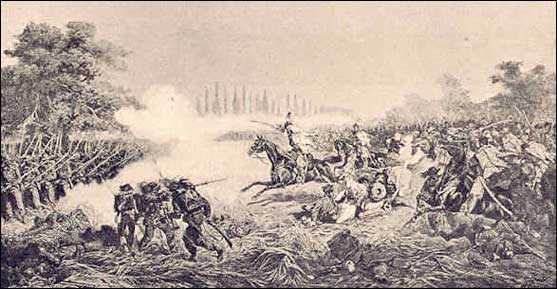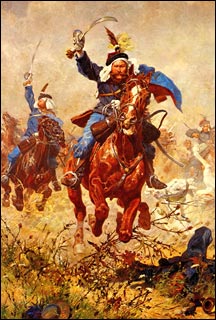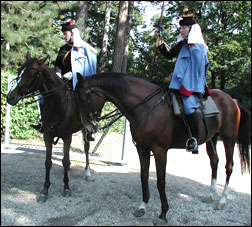
Avalanche Press
Presents
| Second
Custoza: Charge to Glory Second Custoza is often called a “soldier’s battle,” a dramatic way of saying that both command staffs lost control of their forces and let them brawl fairly unchecked until the Italian army gave way. On 24 June 1866, Austria managed to pull out a major field victory to salve the army’s pride. In a previous installment we looked at Austrian and Italian preparations for the battle. Today, we’ll look at the role of the Austrian cavalry in the battle. Archduke Albrecht held titular command of the Austrian Southern Army, but his chief of staff, Franz Freiherr von John, laid out the Austrian battle plan for the corps commanders. Five formations would take up a broad east-west arc facing the Italians. The far right (the Reserve Division) would swing forward, to the south, and separate the Italians from the key bridges over the Mincio River. The far left (the Cavalry Reserve) would pull back, drawing the Italian forward to help spring the trap. Austria's cavalry represented the army's social elite. As in all other European armies of the period, Austrian practice divided the cavalry into heavy and light regiments. Heavy cavalry — in the Austrian army, cuirassiers and dragoons — selected big men on big horses, to provide shock action on the battlefield. In 1860 the cuirassiers lost their armored breastplates. Northern Army light cavalrymen received carbines (some of them very effective breechloaders) just before the 1866 war; Southern Army's troop-ers made do with a horse pistol. More emphasis on scouting and skirmishing was also laid on the light cavalry. All of the army's heavy cavalry served in Northern Army in 1866. Albrecht and John tapped Col. Ludwig Pulz, commander of the 13th “Trani” Uhlans, to lead Southern Army cavalry reserve. They scrounged a hospital section and a horse artillery battery from Army assets, but his two brigades had only 16 squadrons between them. Pulz kept one under his personal control, and assigned the other to Col. August Bujanovics de Agg-Telek. On the afternoon of 23 June the Southern Army's cavalry reserve occupied positions south of Verona. During the night John directed Bujanovics to send a cavalry squadron led by a "resourceful and organized" captain to undertake a thorough reconnaissance of the territory between the Mincio and the Adige. Accordingly, Bujanovics dispatched Rittmeister Wilhelm Graf Pálffy-Daun ab Erdöd and his squadron of the 3rd "Prinz Karl von Bayern" Hussar Regiment. Pálffy-Daun and his men left their bivouacs at about 2:30 a.m. on 24 June. The hussars found that the Italian advance had not yet begun, and well before their 4 a.m. return Army headquarters ordered the cavalry brigades to prepare to move out.
Bujanovic’s brigade occupied the extreme left flank of the Austrian army, with Pulz's brigade to the north between Bujanovics and IX Corps. The leading squadron, Rittmeister Michael Hertlein’s 2nd Squadron of the 11th “Prinz von Württemburg” Hussar Regiment, reported spotting an Italian cavalry squadron on the Calori heights. The Austrian cavalry could not close with the enemy horsemen, and continued to move cautiously down the main road toward Villafranca. Pulz's cavalry brigade hit the road at 3 a.m. and then waited in march order for several hours while Bujanovics’ brigade caught up. The first contact, however, came from Bujanovics’ troopers. Hertlein’s squadron finally caught up with and charged the Italian horsemen. The Italians withdrew behind a pair of infantry battalions from Prince Umberto’s 16th Infantry Division of the Italian III Corps. Enrico Della Rocca’s Italian III Corps had moved out shortly before 4 a.m. All four of Della Rocca’s divisions had crossed the Mincio on the 23rd, taking most of the day to do so, and then camped immediately afterwards around Goito. Cugia's 8th Division marched on the left flank of the corps, keeping contact with I Corps. Nino Bixio’s 7th Division and Prince Umberto’s 16th marched by parallel roads on Villafranca and Somma Campagna, while Govone’s 9th Division trailed behind as the corps reserve. Though Della Rocca had been assigned Pralormo's brigade of light cavalry, consisting of the Saluzzo and Alessandria light horse and the Foggia lancers, he posted them behind Bixio’s division where they could neither scout ahead nor repel the Austrian cavalry. Each division included a squadron of the Alessandria light horse (one more remained as Della Rocca's personal escort), and these horsemen performed all the corps’ scouting and screening missions. Hertlein’s rash attack on the Alessandria light horse drew more and more Austrian cavalry forward as both Bujanovics and Pulz committed additional squadrons. The Austrians came under Italian infantry and artillery fire, but could not come to grips with the Italian light horse. The 'Heroic Assault'
With that, Rodakowski, his lancer's dolman and long mustaches flowing behind him, spurred his big chestnut charger forward and flung his entire regiment on the nearest Italian infantry. Pulz, in his post-battle report, feigned complete ignorance of Rodakowski’s suicidal attack — though he seems to have had no second thoughts about afterwards collecting the Military Order of Maria Theresa for the “heroic assault.” Rodakowski received the slightly less prestigious Order of Leopold; it may have helped that Rodakowski’s brother, Josef, occupied a senior slot at the War Minstry. Maximilian had also been one of the great Radetzky’s favorites during the 1848 campaign, making his mark as a fearless 22-year-old dispatch rider. The 13th Uhlans were one of the Austrian army's newest regiments, formed in 1860 from Polish volunteers gathered for the 1859 war. Its banners carried no battle honors; a lack which chafed at its officers, given the overpowering prestige-consciousness in the Austrian cavalry arm. With such a pedigree, the regiment’s great enthusiasm and vast lack of battle discipline are not surprising. Rodakowski had served as Pulz’s second-in-command from the regiment’s formation. If Pulz did not order the ill-advised assault — and there is no evidence to suggest that he did — he also had no one else to blame for his regiment's impulsive behavior. The attack caught everyone by surprise, including Prince Umberto, who along with his staff desperately lunged into a square formed by the Parma Brigade just in time. The heir to the throne of Italy stood his ground, according to Della Rocca, with “all the qualities of a good soldier.” Though Della Rocca claimed that the Austrian cavalry burst out of dense cover close to the Italian positions, Austrian reports admit that Rodakowski's charge came across open ground. The Italian infantry had plenty of time to form squares to resist the attack. The Bersaglieri, who had fanned out in a screen of skirmishers, returned to shelter within the close double ranks of the infantry and opened a murderous fire on the Austrians.
Rodakowski's lancers passed through the Italian infantry squares only to crash into a deep ditch. There, Pulz wrote later, their horses somersaulted through the air and lancers spilled to the ground. As the regiment attempted to get across the obstacle, the horsemen presented slow moving or immobile targets for the Bersaglieri, who emptied many Austrian saddles with their deadly fire. Things only got worse from there. Pulz's other regiment, the 1st “Kaiser Franz Josef” Hussars, followed Rodakowski’s attack with one of their own while Bujanovics flung all seven of his squadrons into yet another mad charge. The hussars charged three squadrons of the Alessandria light horse, who withdrew behind another set of infantry squares. Once again, the Austrian horsemen came under deadly infantry fire. The Italian CollapseFortunately for Pulz, Della Rocca and Prince Umberto harbored no aggressive thoughts. The Austrian cavalry spent the rest of the morning collecting stragglers from the attacks and resting its horses. With action always imminent, the Austrians could not afford to unsaddle their mounts, limiting the usefulness of the operational pause. The cavalry, wrote Maj. Gen. Karl Möring, a brigade commander in V Corps, “has been taken care of by the genius of Pulz and Bujanovics. What I have heard of their heroism shows the mark of the most brave officers, but they are completely incompetent leaders.” Italian inaction, Pulz explained, probably came from the determination of Nino Bixio, commander of the 7th Division, to hew to “the dictates of the law” and strictly follow orders rather than act with initiative. But it was actually Della Rocca who vetoed Bixio's proposal to attack the point where IX Corps’ left flank met Pulz’s cavalry. “We settled, however, that he should wait for a positive order from General La Marmora or from me,” Della Rocca wrote later, “and meanwhile retain his positions.”
Pulz’s hussars began to round up dozens of dazed and exhausted Italian soldiers from the divisions which had fought on the Custoza heights. “Entire units lay down their arms,” Pulz reported, “coming over to us, and in Villafranca others refused to serve further.” A patrol from the 1st Hussar Regiment stumbled upon a seemingly battle-ready Italian artillery battery, which declined to fire on the startled horsemen. This, Pulz wrote, symbolized the “complete demoralization of the enemy.” As night fell the cavalry reigned in and allowed the Italians to pour over the bridges into Lombardy. Lack of an aggressive cavalry pursuit drew criticism from some later authors, but like many things that “everyone knows,” the notion that cavalry can ride down a defeated army lies mostly in the realm of myth and legend. After the Napoleonic Wars, only two post-battle cavalry pursuits of the “classic” type took place, neither of them in Europe. George Thomas’ Union horse-men shredded the Confederate Army of Tennessee in 1864 after John Bell Hood, operating in an opium-induced state of paranoia, ordered his own army to its destruction at Nashville. And after the Battle of Cedar Creek, the Union cavalry rode down much of Jubal Early's Confederate army. Yet even these pursuits had critics who charged that more could have been accomplished, or that their results were overstated. Rodakowski’s bizarre attack fit standard Austrian practice of the time. “Cavalry is a weapon,” wrote Prince Emmerich zu Thurn und Taxis, commander of Northern Army's 2nd Light Cavalry Division and pre-war head of the cavalry school. “The officer corps of the Imperial-Royal Army must act as true descendants of knighthood.” It would be Della Rocca’s actions — shocking malfeasance bordering on treason — that did far more to hamper the Italian effort than Pulz could hope to achieve. |
© Avalanche Press LTD, all rights reserved.



